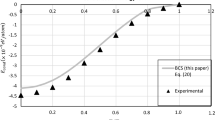Abstract
We calculate analytically the conductivity of weakly disordered metals close to a “ferromagnetic” quantum critical point in the low-temperature regime. Ferromagnetic in the sense that the effective carrier potential \(V(q,\omega )\), due to critical fluctuations, is peaked at zero momentum \(q=0\). Vertex corrections, due to both critical fluctuations and impurity scattering, are explicitly considered. We find that only the vertex corrections due to impurity scattering, combined with the self-energy, generate appreciable effects as a function of the temperature T and the control parameter a, which measures the proximity to the critical point. Our results are consistent with resistivity experiments in several materials displaying typical Fermi liquid behaviour, but with a diverging prefactor of the \(T^2\) term for small a.


Similar content being viewed by others
Notes
For the use of functions \(f(\epsilon )\) and \(n(\omega )\), we follow Ref. [13].
References
J. Paglione, M.A. Tanatar, D.G. Hawthorn, F. Ronning, R.W. Hill, M. Sutherland, L. Taillefer, C. Petrovic, Phys. Rev. Lett. 97, 106606 (2006)
A. Bianchi, R. Movshovich, I. Vekhter, P.G. Pagliuso, J.L. Sarrao, Phys. Rev. Lett. 91, 257001 (2003)
S.A. Grigera, R.S. Perry, A.J. Schofield, M. Chiao, S.R. Julian, G.G. Lonzarich, S.I. Ikeda, Y. Maeno, A.J. Millis, A.P. Mackenzie, Science 294, 329 (2001)
P. Gegenwart, J. Custers, C. Geibel, K. Neumaier, T. Tayama, K. Tenya, O. Trovarelli, F. Steglich, Phys. Rev. Lett. 89, 056402 (2002)
P. Gegenwart, J. Custers, Y. Tokiwa, C. Geibel, F. Steglich, Phys. Rev. Lett. 94, 076402 (2005)
N.P. Butch, K. Jin, K. Kirshenbaum, R.L. Greene, J. Paglione, PNAS 109, 8440 (2012)
T. Shibauchi, L. Krusin-Elbaum, M. Hasegawa, Y. Kasahara, R. Okazaki, Y. Matsuda, PNAS 105, 7120 (2008)
L. Balicas, S. Nakatsuji, H. Lee, P. Schlottmann, T.P. Murphy, Z. Fisk, Phys. Rev. B 72, 064422 (2005)
S. Nakatsuji, K. Kuga, Y. Machida, T. Tayama, T. Sakakibara, Y. Karaki, H. Ishimoto, S. Yonezawa, Y. Maeno, E. Pearson, G.G. Lonzarich, L. Balicas, H. Lee, Z. Fisk, Nat. Phys. 4, 603 (2008)
J.G. Analytis, H.-H. Kuo, R.D. McDonald, M. Wartenbe, P.M.C. Rourke, N.E. Hussey, I.R. Fisher, Nat. Phys. 10, 194 (2014)
H.V. Löhneysen, A. Rosch, M. Vojta, P. Wölfle, Rev. Mod. Phys. 79, 1015 (2007)
G. Kastrinakis, Europhys. Lett. 112, 67001 (2015)
A.A. Abrikosov, L.P. Gorkov, I.E. Dzyaloshinski, Methods of Quantum Field Theory in Statistical Physics (Prentice-Hall, Cliffwoods, NY, 1964)
P.A. Lee, T.V. Ramakrishnan, Rev. Mod. Phys. 57, 287 (1985)
J. Hertz, Phys. Rev. B 14, 1165 (1976)
A.J. Millis, Phys. Rev. B 48, 7183 (1993)
G. Kastrinakis, Phys. Rev. B 72, 075137 (2005)
G.D. Mahan, Many-Particle Physics, 2nd edn. (Plenum Press, New York, 1990). (the relevant material is mostly in section 3 of chapter 7)
L. Dell’ Anna, W. Metzner, Phys. Rev. Lett. 98, 136402 (2007). (erratum Phys. Rev. Lett. 103, 159904 (2009))
A.V. Chubukov, D.L. Maslov, Phys. Rev. Lett. 103, 216401 (2009)
S.S. Lee, Phys. Rev. B 80, 165102 (2009)
Author information
Authors and Affiliations
Corresponding author
Appendices
Appendix A: On the Calculation of the Scattering Rate
The derivation below follows that of [12], i.e. (I), and equation numbers refer to (I) as well. In the limit \(T \rightarrow 0\) the thermal function \(X= \coth (\omega /2T) \; + \; \tanh ((\epsilon -\omega )/2T)\) in Eq. (I-4) becomes \(X=2\) for \(2T< \omega <\epsilon \), and \(X=0\) for \(\omega <-2T\) and \(\omega >\epsilon \). Then the integration over \(\omega \)—compare with Eq. (I-7)—amounts to
for \( h_q \; a_q > \epsilon \). The rest of the algebra proceeds as in Eq. (I-8) and onwards. Thus, the scattering rate scales like \(\epsilon ^2\) as well, as expected for the FL regime.
Appendix B: The Terms \(R_V,R_1,R_2,L\) in Eq. (15)
The terms \(R_1,R_2\) each contain a single propagator G. Hence, upon the final integration over momentum k they both yield a small contribution. This is the case because this integration is similar to an integration over \(\epsilon _k\) from \(-\infty \) to \(+\infty \), which can be taken as part of a contour integral closing at infinity. That contour can be taken such that the pole of the G in the integrand lies outside of it and hence yields a zero contribution. C.f. also Ref. [18].
The term \(R_V\) is due to the residue from the pole \(z=z_0=-i \; a_q \; h_q\) of V(q, z). Here both G’s enter the formula for the residue. However, their poles are on the same semi-plane (i.e. in a combination \(G^A G^A\)), and the argument for \(R_1,R_2\) applies as well.
The term L is the residue from the 2 poles \(z=z_k,z_k^*\) of \(\Lambda (k,z)\)—c.f. Eqs. (36), (37)—with
Considering the function
we have
This term is much smaller than \(I_V\) because \(|\text {Im} \; H(z)| \ll |\text {Re} \; H(z)| \).
Rights and permissions
About this article
Cite this article
Kastrinakis, G. Conductivity of Weakly Disordered Metals Close to a “Ferromagnetic” Quantum Critical Point. J Low Temp Phys 191, 123–135 (2018). https://doi.org/10.1007/s10909-017-1847-2
Received:
Accepted:
Published:
Issue Date:
DOI: https://doi.org/10.1007/s10909-017-1847-2




